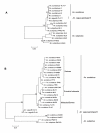Malaria vectors of Timor-Leste
- PMID: 20122278
- PMCID: PMC2829033
- DOI: 10.1186/1475-2875-9-40
Malaria vectors of Timor-Leste
Abstract
Background: The island of Timor lies at the south-eastern edge of Indonesia on the boundary of the Oriental and Australian faunal regions. The country of Timor-Leste, which occupies the eastern part of the island, is malarious, but anopheline faunal surveys and malaria vector incrimination date back to the 1960 s. Over the last decade the malaria vectors of south-east Asia and the south-west Pacific have been intensely studied using molecular techniques that can confirm identification within complexes of isomorphic species. The aim of this study is to accurately identify the Anopheles fauna of Timor-Leste using these techniques.
Methods: The survey was carried out over the period February to June 2001. Standard entomological techniques--human landing collections, larval collections and CO2 baited light traps--were used to collect anophelines from the main geographical regions: coastal plains, inland plains, and highlands. Specimens were processed for identification by morphology and genotyped for the ribosomal DNA ITS2 by restriction analysis and/or DNA sequencing. Phylogenetic relationship of Anopheles sundaicus and Anopheles subpictus individuals was also assessed using DNA sequences from the ITS2 and mitochondrial cytochrome-b. All specimens, other than those from larval surveys, were processed to detect the presence of the Plasmodium parasite circumsporozoite protein by ELISA for vector incrimination.
Results: Of 2,030 specimens collected, seven species were identified by morphology: Anopheles barbirostris, Anopheles aconitus, Anopheles annularis, Anopheles maculatus, Anopheles peditaeniatus, An. sundaicus and Anopheles vagus. These were confirmed by molecular analysis with the addition of Anopheles flavirostris and an unidentified species designated here as An. vagus genotype B. This latter species was morphologically similar to An. vagus and An. subpictus and is likely to be the An. subpictus described by other workers for Timor. However, genetically this species showed strong affinities to the An. sundaicus complex. Anopheles vagus was the most common species but was rarely collected coming to bite humans; An. barbirostris and An. vagus genotype B were the two most common species collected in human landing catches and both were found positive for CS protein.
Conclusions: The anopheline fauna of Timor-Leste is of Oriental origin with no evidence of elements from the Australian Region. The existence of species complexes will make the use of morphological markers problematic in the country. Using molecular analysis a number of issues regarding the anopheline fauna of Timor-Leste were resolved and nine putative species of Anopheles were identified; two species: An. barbirostris and An. vagus genotype B, were incriminated as malaria vectors.
Figures


Similar articles
-
Molecular characterization of Anopheline (Diptera: Culicidae) mosquitoes from eight geographical locations of Sri Lanka.Malar J. 2017 Jun 2;16(1):234. doi: 10.1186/s12936-017-1876-y. Malar J. 2017. PMID: 28578667 Free PMC article.
-
Genetic evidence for malaria vectors of the Anopheles sundaicus complex in Sri Lanka with morphological characteristics attributed to Anopheles subpictus species B.Malar J. 2010 Nov 29;9:343. doi: 10.1186/1475-2875-9-343. Malar J. 2010. PMID: 21114832 Free PMC article.
-
Survey of Anopheles mosquitoes (Diptera:Culicidae) in West Sumba District, Indonesia.Southeast Asian J Trop Med Public Health. 2011 Jan;42(1):71-82. Southeast Asian J Trop Med Public Health. 2011. PMID: 21323168
-
Evidence-based malaria control in Timor Leste from 2006 to 2012.Malar J. 2015 Mar 11;14:109. doi: 10.1186/s12936-015-0614-6. Malar J. 2015. PMID: 25890294 Free PMC article. Review.
-
Is there an efficient trap or collection method for sampling Anopheles darlingi and other malaria vectors that can describe the essential parameters affecting transmission dynamics as effectively as human landing catches? - A Review.Mem Inst Oswaldo Cruz. 2014 Aug;109(5):685-705. doi: 10.1590/0074-0276140134. Mem Inst Oswaldo Cruz. 2014. PMID: 25185008 Free PMC article. Review.
Cited by
-
The dominant Anopheles vectors of human malaria in the Asia-Pacific region: occurrence data, distribution maps and bionomic précis.Parasit Vectors. 2011 May 25;4:89. doi: 10.1186/1756-3305-4-89. Parasit Vectors. 2011. PMID: 21612587 Free PMC article.
-
Bionomic aspects of the Anopheles subpictus species complex in Sri Lanka.J Insect Sci. 2014;14:97. doi: 10.1673/031.014.97. J Insect Sci. 2014. PMID: 25205254 Free PMC article.
-
Investigation of malaria vectors Anopheles in non-endemic areas of Thailand: in proximity to workplaces housing foreign migrant workers.Malar J. 2025 Jan 20;24(1):18. doi: 10.1186/s12936-025-05253-5. Malar J. 2025. PMID: 39833851 Free PMC article.
-
Molecular characterization and identification of members of the Anopheles subpictus complex in Sri Lanka.Malar J. 2013 Aug 30;12:304. doi: 10.1186/1475-2875-12-304. Malar J. 2013. PMID: 24001126 Free PMC article.
-
A systematic review: is Anopheles vagus a species complex?Malar J. 2024 Mar 27;23(1):88. doi: 10.1186/s12936-024-04888-0. Malar J. 2024. PMID: 38539155 Free PMC article.
References
-
- David HL. Some features of malaria in Dili, Portuguese Timor, during 1963-64. Ann Trop Med Parasitol. 1965;59:147–152. - PubMed
-
- Audley-Charles MG. In: Geological history of the region of Wallace's Line. Whitmore TC, editor. Oxford: Clarendon Press; 1981. pp. 24–35.
-
- Lee DJ, Woodhill AR. The anopheline mosquitoes of the Australasian Region. Glebe, Sydney: Aust Med Pub Co Ltd; 1944.
-
- Brug SL, Bonne-Wepster J. The geographical distribution of the mosquitoes of the Malay Archipelago. Chronica Natura. 1947;103:179–196.
MeSH terms
Substances
LinkOut - more resources
Full Text Sources
Medical
Molecular Biology Databases

